The new BMW X5 M and X6 M drive like cars half their weight and also have every interior feature imaginable if you want. And yet. You get a nagging feeling behind the wheel, which isn’t the car’s fault. No, the car is good. But the questions that linger are: Who is this car for, exactly? What is this car for? Why is car?
(Full Disclosure: BMW put me up in a hotel in Scottsdale, Arizona, and gave me food so that I could drive the X5 M Competition and X6 M Competition for over seven hours across the 48th state. They also gave me booze when I asked for it. Everyone was very nice.)
Let’s start with some context since there are a great many people who think that the M SUVs are bad, a dead-on-arrival concept that maybe shouldn’t exist at all. I am not one of them for reasons that I will get into later, but I will say that at the press drive this week I watched many a motoring journalist spontaneously combust. “The M badge has been cheapened beyond repair,” they muttered as they went up in flames. “This car is bad but I can’t explain why,” they said as fire began to emerge from their ear canals. “I refuse in my position as a car reviewer to consider this nonsense,” they said as smoke emerged from their nostrils.
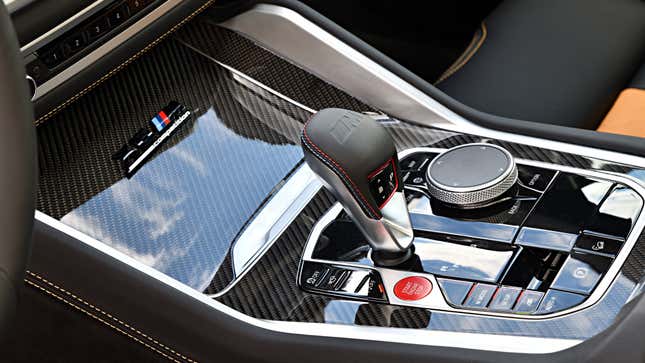
Aside from being boring, these arguments ignore the simple fact of the matter, which is that BMW is making M SUVs, and have been for some time now, and apparently selling quite a few of them, if BMW M’s 2019 results are anything to go by. BMW M doesn’t reveal sales figures for particular models, but it did say in January global M sales increased by a staggering 32 percent last year, with much of that growth coming in the U.S. where 44,442 M models sold, M’s biggest market.
Those numbers are also in part because the market for hot SUVs is relatively new in the context of the car industry, having really grown up only in the past couple of decades. The 1991 GMC Typhoon retroactively looks like a real trend-setter in 2020.
But the Typhoon was built more for straight-line performance, while BMW has been designing its M SUVs for the track pretty much since the X5 M and X6 M’s introduction in 2009. Today, we have a car that produces 45 more horsepower than its original and with more agility than you would ever expect from something that also weighs over 5,300 pounds.
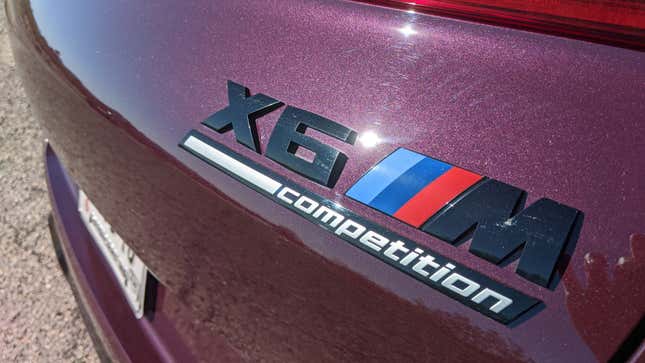
What Is It?
It’s the third-generation X5 M and the third-generation X6 M, both now with more horsepower. These are cars for people who think Atlantic City is cool. But no judgment here, I’m a big fan of Atlantic City. The main competitors of the X5 M and X6 M are cars like the Mercedes-AMG GLE 63 S, Porsche Cayenne (and Cayenne Coupe) Turbo, and Maserati Levante GTS, though no one seems to get too charged up about those cars.
That’s perhaps because the M label means a little bit more to its fans than even AMG, for reasons both complicated and not. BMW knows this, of course, and that’s why we’ve seen such a proliferation of the M badge because at the very least the company knows it still makes a stir.
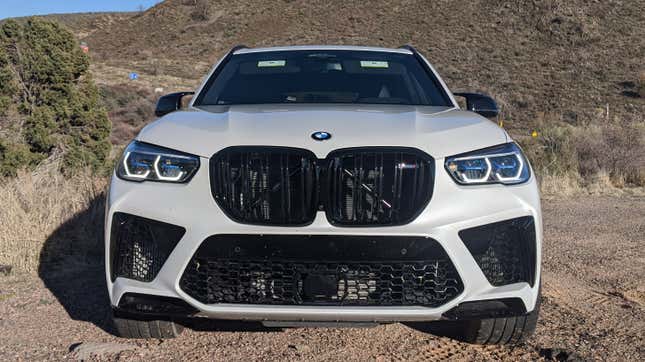
Specs That Matter
Both cars have rear-biased all-wheel drive powered by twin-turbocharged 4.4-liter V8s that BMW says put out 600 horsepower, mated to 8-speed automatic transmissions. The Competition models use the same engine but claim an extra 17 horsepower with the same amount (553 lb-ft) of torque. All of that power comes at a cost, of course, in the form of 15 mpg combined fuel mileage on the cars I tested, according to the EPA.
That is also just where things start. On the inside, you can set the computer to change various aspects of the car’s behavior with road and sport modes, in addition to a track mode on the Competition models. These work as they do elsewhere, stiffening the suspension in more sporty modes, giving it more acceleration in others. More granularly, you can even set braking to comfort and sport modes, which tells the computer to tell the brakes to respond differently to harder pushes of the pedal.
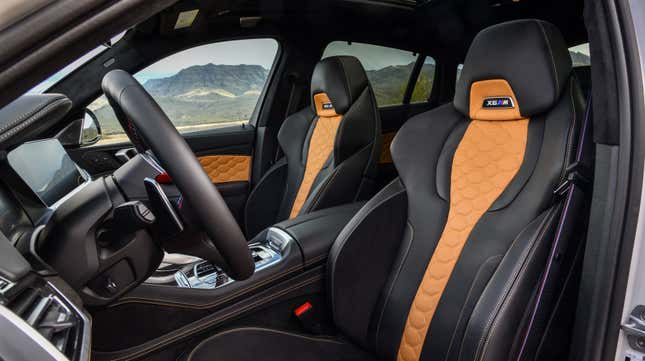
Functionally speaking, however, when you push down on the gas pedal both the X5 M and the X6 M will put you into the back of your seat in any mode. And when you are going at high speeds on the highway, the outside world may or may not even exist, since 75 mph feels no different than 25 mph, or almost even zero mph, in any mode, one of the true wonders of modern fast cars being the flattening effect they have on how speed feels. BMW says the X5 M Competition will do 0-60 in 3.9 seconds, with the X6 M Competition doing it in 3.8 seconds.
On the inside, there is a dizzying array of buttons everywhere, in addition to a big screen. This is the part of the review where I would normally complain about how complicated all of these things are, but if you’re buying a $131,000 BMW that just kind of goes with the territory. Suffice to say these cars have climate control, BMW’s full array of driver assistance features, and, well, actually, here are the relevant portions of the cars’ Monroney statements.
First, the X5 M Competition:
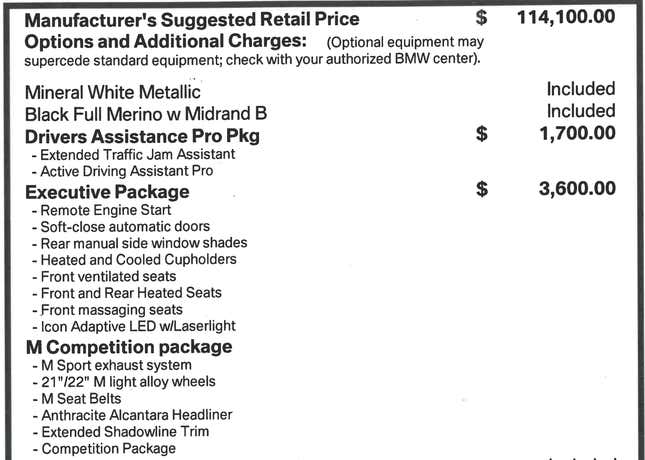
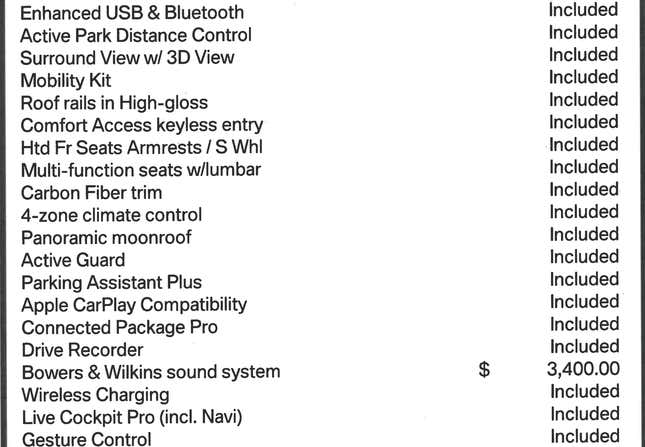

And the X6 M Competition:

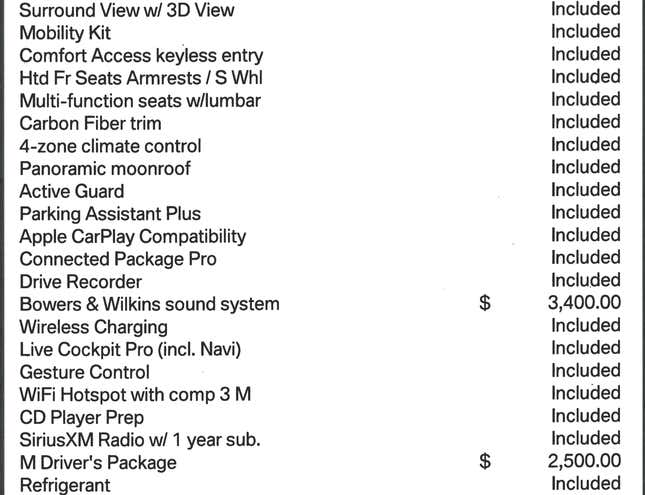

If you’re not noticing a ton of differences between the two that is because there aren’t many, really. The X5 and X6 are identical in almost every way save cargo space, some styling, and the position of grips on the interior. The X6 M is actually the lighter of the two cars, by 50 pounds, weighing in at 5,375 pounds curb weight, owing to its more crossover-y shape.
Whichever one you prefer will probably depend on your feeling on whether crossovers are good or bad, but let’s not get into that.
What’s Great
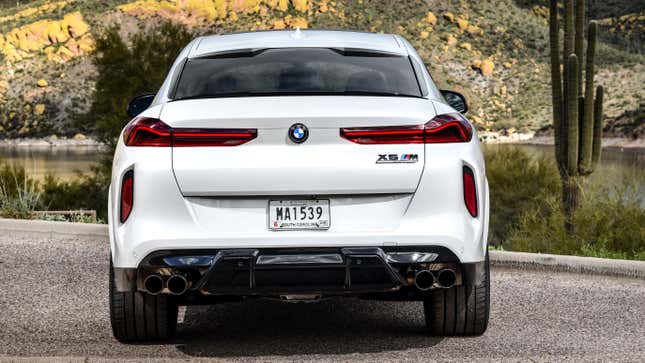
What’s great is the power, of course, which is what you come to M for. I haven’t driven the Mercedes AMG GLE, though my co-driver, an editor at Autoweek, did recently drive the GLE, declaring the X5 M and X6 M “better,” a stance which made a bunch of motoring journalists mad for reasons known only to themselves.
That said, in my time with the X5 M and X6 M, both cars hugged turns ably, went up and down the speedometer effortlessly—most noticeable above 60 mph, when the car only lost a little of its oomph—and worked through its eight gears almost imperceptibly, as it was at least an hour or two before I noticed that the cat had a transmission at all.
Inside, the moonroof is very large, and the seats—leather, of course—very comfortable and adjustable in every which way to your heart’s content. I did not sit in the rear seats, because I wanted to get in as much drive time as possible, but it looked comfortable back there as well.
What’s Weak
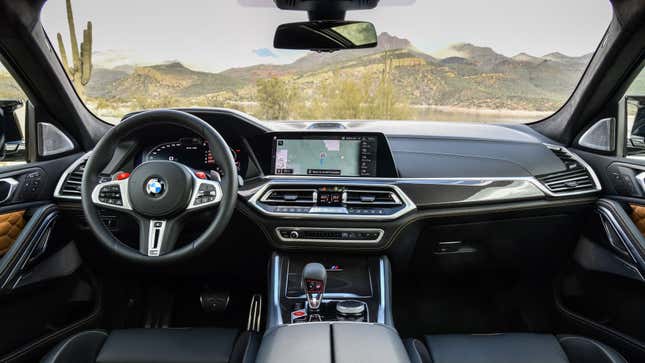
Rear visibility on the X6 M is utterly atrocious, with the rear window in this configuration almost there purely for aesthetic reasons. The good news is that the backup cameras all functioned. Rear visibility in the X5 M was markedly improved, one of the only real differences between the cars in terms of the actual driving.
More curious, the X5 M felt and drove smaller, even though it is, on paper, the heavier car. I think it feels like this mostly because of BMW’s decision to put hand grips on the interior of the front doors of the X6 M. Those grips look like this:
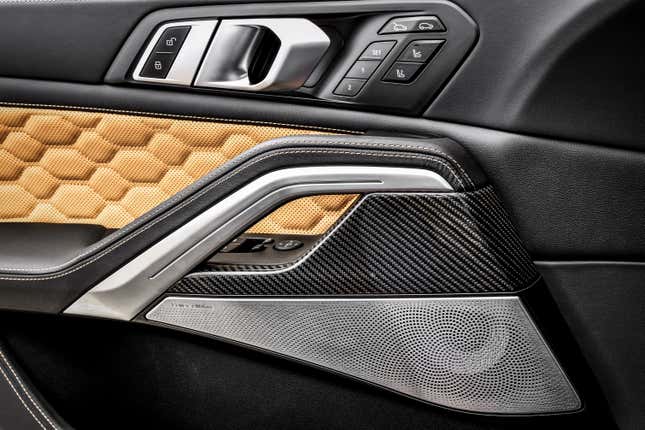
In the X5 M the corresponding part is this:
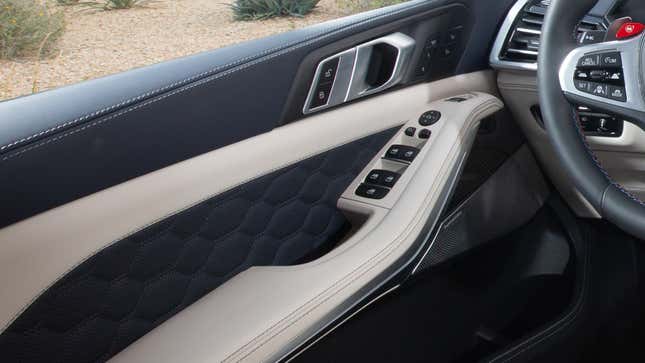
You would be surprised by how much harder the grip makes it to access the buttons to the driver’s left, but I’m nitpicking.
Early Verdict
There is something ridiculous about unveiling an overpowered gas-guzzling SUV that sells for six-figures in an era of global wage stagnation and climate change, but the fact that BMW thinks it will sell more than enough of these to justify its decision to make them tells you all you need about capitalism.
Which is why, ultimately, it’s kind of impossible to evaluate a car like the X5 M or X6 M, discordant as they are with broader trends. They do what they do very, very well, but at what cost (both literally and figuratively), and why?

Any hallowedness concerning the M badge should be cast aside, at any rate, since slapping an M badge on a street-legal car has been marketing since the very beginning, launched on the back of BMW’s racing program to sell cars to people who thought of themselves as racers too.
The marketing only reaches the ridiculous with the X5 M Competition and X6 M Competition, both names carrying the faintly hilarious implication that these cars will ever compete in anything outside of an ego contest between dads on Long Island. But marketing is only bad insofar as you buy into it. I can only report that the car, taken alone, is good; how you spend your money is between you and your god.
Still, who is this car for? If you want something for the track, you’ve got a lot of car options at $131,000. Most of those will be quicker, handle better and probably look cooler; if you want something to ferry your large children around, you’ve got a lot of good options for far less than $131,000, and should probably just go with your instinct and get a Volvo XC60. If you want something to carry out both jobs, you might be a little bit insane, but BMW is doing its best to check off both boxes, whether that’s a good thing or not.
